- Best Cultivator Attachments Guide - December 23, 2021
- How to Find the Best Leaf Blower Attachment - December 23, 2021
- Best 21 Inch Lawn Mower Blade Options - December 18, 2021
If people often tread on your yard, then it’s best to get a type of grass that will support high foot traffic. Some high-traffic grass will even support the use of heavy machinery. Unfortunately, some grass types will struggle to recover from foot traffic, and there’s a chance they won’t heal at all.
If you’re looking for the best high-traffic grass type, then this article will help.
In this High Traffic Grass Guide, we’ll be covering the various types of grass tolerant to lots of foot traffic and the best products to use for high-traffic grass.
Grass Types With Tolerance To High Traffic
The two best types of grass for high traffic tolerance are Zoysia and Bermudagrass. Kentucky Bluegrass is also good at withstanding heavy foot traffic.
Before purchasing any type of grass, be sure that you have enough time to look after it if it’s a grass type that requires higher maintenance.
Below I’ve listed the positives and negatives of these grass types. I’ve also described the steps to taking care of the grass. To withstand foot traffic, you’ll need to keep your grass healthy with fertilizer and water. You’ll also need to mow it regularly.
Bermudagrass
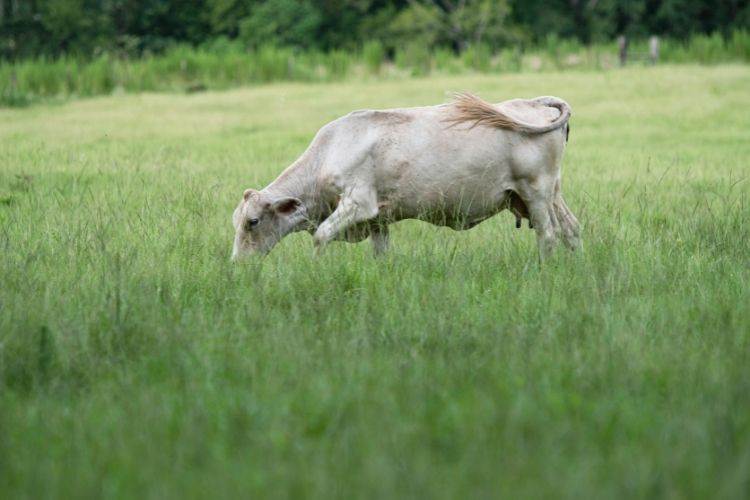
Bermudagrass is often used in public parks due to its ability to withstand heavy foot traffic. It will quickly repair itself if it does take damage.
Caring For Bermudagrass
To keep Bermudagrass strong and healthy, you’ll need to properly look after it, as unhealthy grass will start to brown, and it won’t be nearly as effective in withstanding foot traffic. Bermudagrass has fairly low maintenance in comparison to other grass types in this article.
Watering
You should give your bermudagrass around 1 inch of water at least once a week. During drought, you should water your grass three times a week. Bermudagrass is great during heat, but you still need to keep it from drying up like any grass.
Mowing
You should mow Bermudagrass every 6 days. Unless the grass is stressed in which you should probably leave it even longer. You can tell your grass is stressed if:
- Weeds begin to sprout
- There are brown patches
- The blades begin to curl
- Footprints are still visible
To fix this issue, water your grass regularly until it begins to change. This is likely happening because the grass has dried up.
Fertilizing
You should use fertilizer on your grass once a month. This will help with improving the wear and tear resistance, especially in rough weather conditions.
Sunlight And Shade
Bermudagrass must stay in direct sunlight as often as possible. Bermudagrass doesn’t have the best resistance against shade. It will quickly start to go dormant if kept in it for too long.
Advantages Of Bermudagrass
Bermudagrass is incredibly low maintenance, to the point where you’ll only need to mow your grass around once a week. It also doesn’t require a lot of water unless you’re experiencing a heavy drought period.
It does have the ability to withstand a lot of wear and tear. But, especially if paired with a great fertilizer, it will quickly repair itself thanks to its rapid growth rate. It’s one of the best grass types for households with pets and kids who enjoy playing on the lawn.
It’s best to grow bermudagrass in warmer temperatures as that is when it will thrive. It does have an aggressive growth rate, and this can lead to issues. But it also makes the germination quick, lasting 7 to 14 days.
Disadvantages Of Bermudagrass
Due to its aggressive growth, you might find bermudagrass overly invasive. It can quickly spread to other parts of your yard, such as flowerbeds. Meaning you’ll need to keep it contained as you can.
In colder weather, you’ll find it to be a bit temperamental. It will quickly brown and could even start to go dormant. This can also happen if it’s in shaded areas of your yard. It needs as much sunlight and warmth as possible.
Zoysiagrass
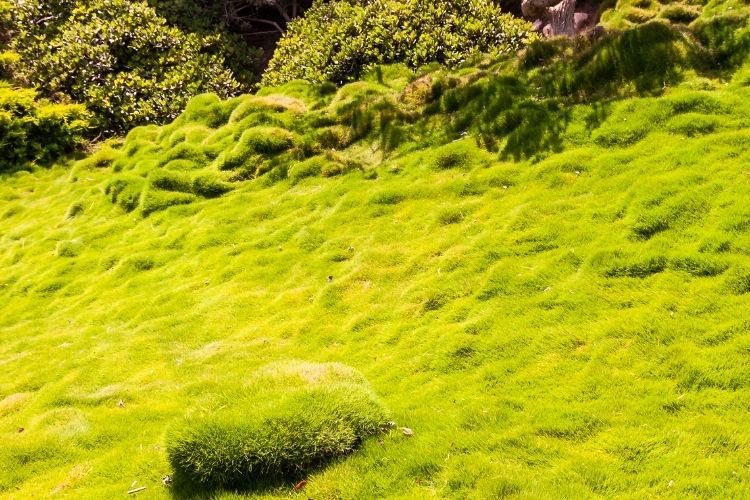
Zoysiagrass is another excellent choice for a tough grass type. It’s also known for its tolerance to warm temperatures.
Caring For Zoysiagrass
Zoysiagrass is low maintenance, but the germination period is longer than similar seeds. It can take between 14 and 21 days to establish fully.
Watering
You only need to water Zoysia when it looks like it will need it. If the grass starts to brown, then that’s a sign that it’s too dry. Zoysia is resistant to heat, so it will take long periods of extreme drought to dry up.
Mowing
Zoysiagrass will need mowing at least once a week to keep it clean and healthy. I recommend you mow to a height of 1½ inches.
Fertilizing
Zoysia doesn’t require as much fertilizer as other grass types, and you should still use half a pound of fertilizer per 1000 square feet.
You’ll only need to fertilize your grass once a year and after you’ve fed it, give the soil some water. There should be instructions on the packet of fertilizer for the most efficient use.
Sunlight And Shade
Zoysiagrass is tolerant to shade. But it still needs consistent sunlight. It should get around 4-6 hours of direct sunlight each day.
Advantages Of Zoysiagrass
Zoysiagrass is incredibly resistant to warmer temperatures. As a result, you won’t even need to water your grass unless it looks like it’s stressed. This makes it an incredibly low-maintenance grass type.
Zoysia is capable of withstanding heavy foot traffic.
Disadvantages Of Zoysiagrass
Zoysiagrass takes a long time to establish itself. It takes between 14 to 21 days to grow fully, sod is instant results, but it still needs time to establish roots.
In Winter conditions, Zoysiagrass will brown easily. If the grass does die during the Winter, it will need to be replaced when Springtime rolls around again.
Zoysiagrass is more susceptible to weeds rooting. It also needs soil with good drainage for healthy growth.
Kentucky Bluegrass
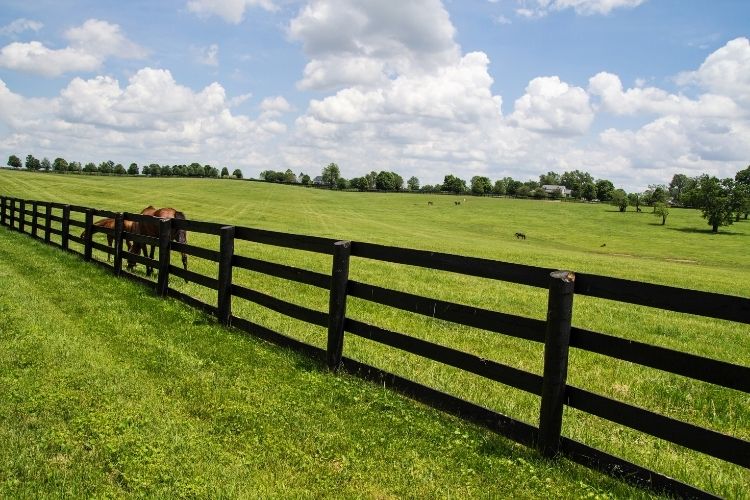
Kentucky Bluegrass is often used in the Northeast. It’s known for being one of the best seeds for overseeding.
Caring For Kentucky Bluegrass
Watering
Kentucky bluegrass doesn’t require watering constantly. If you water your grass once a week, it should be ok. However, too much water can cause disease issues.
Mowing
Kentucky Bluegrass requires a lot of mowing. You should do it at least twice a week to keep it clean. You shouldn’t cut more than a quarter of the blade. If you cut too much, it could potentially cause stress; that’s when it’ll be easier for traffic to damage the grass.
Sunlight And Shade
Kentucky Bluegrass prefers sunlight, and it should get four hours of direct sunlight every day. It can tolerate a bit of shade, but it isn’t as tolerant as other grass types.
Fertilizing
You should wait to fertilize your Kentucky Bluegrass every 6 to 8 weeks during the peak growing season. You should also give it fertilizer if the grass starts to yellow; leaving the grass will allow weeds to sprout. You should give 4 pounds of fertilizer.
Milorganite is the best fertilizer for Kentucky Bluegrass. Milorganite is an organic Nitrogen Fertilizer, and it’s healthier for your grass than most other fertilizers. It will also reduce the time you spend watering and mowing your grass.
Advantages Of Kentucky Bluegrass
Bluegrass is tolerant to heavy foot traffic as long as you keep it healthy. It will also repair itself quickly if it does take damage.
It can be grown in a wide variety of temperatures, making it more accessible to people who don’t get consistent hot weather. Because of this, it’s also tolerant of cold weather.
It’s unlikely that your Kentucky bluegrass will contract diseases as long as you keep it healthy. It will also unlikely weeds will establish themselves.
Disadvantages Of Kentucky Bluegrass
Kentucky Bluegrass requires a lot more maintenance than other grass types. You’ll need to mow at least twice a week to keep it as healthy as possible.
In higher temperatures and drought conditions, Kentucky Bluegrass could struggle to grow, and it could even start to brown. This is when you’ll need to water the grass often to bring it back to full health.
Recommended Products
Scotts Bermudagrass Seed
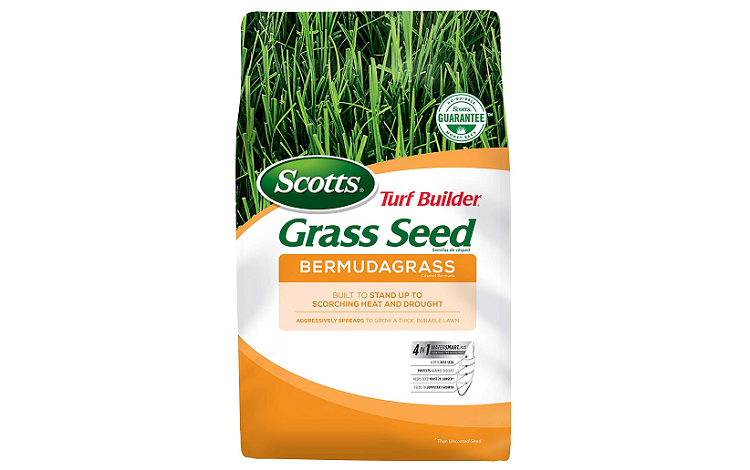
Scotts Bermudagrass is one of the better grass seeds available. It has higher drought resistance than other products available. The 4 in 1 Watersmart coating on these seeds will improve how much water it absorbs, which will lead to better disease prevention.
Pros
- Bermudagrass can tolerate heavy foot traffic, and if it does take damage, it will quickly repair itself
- Resistant to drought
- It can be planted in a large variety of soil qualities
- Fast germination period
Cons
- Can’t withstand shaded areas
- High maintenance
- It can’t tolerate colder temperatures
- Quick growth rate can negatively affect other parts of your yard
Scotts Zoysiagrass Seed And Mulch
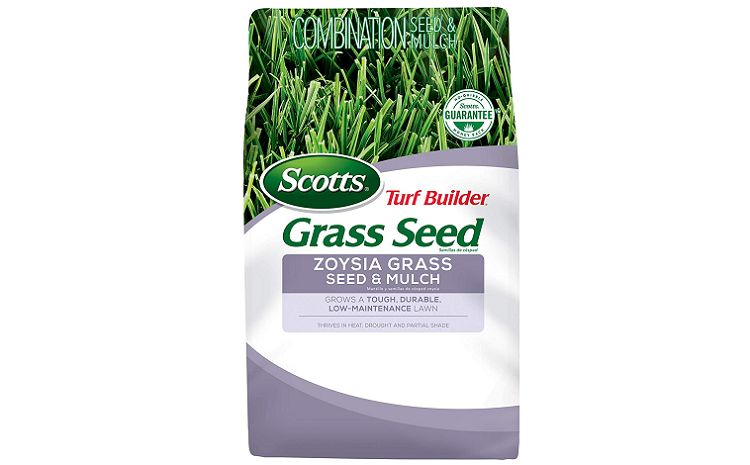
Scott Zoysiagrass has mulch included in the packet. Mulch will help the roots develop healthier. It protects against threats such as weeds and disease. It’ll also help it grow in varying weather conditions.
Pros
- It doesn’t get affected by shade
- The grass will prevent weeds from rooting
- Can withstand heavy foot traffic
- Unlikely to contract diseases
Cons
- It needs high-quality soil with good drainage
- The germination period is longer than most grass types
- Weeds will root easier
Kentucky Bluegrass
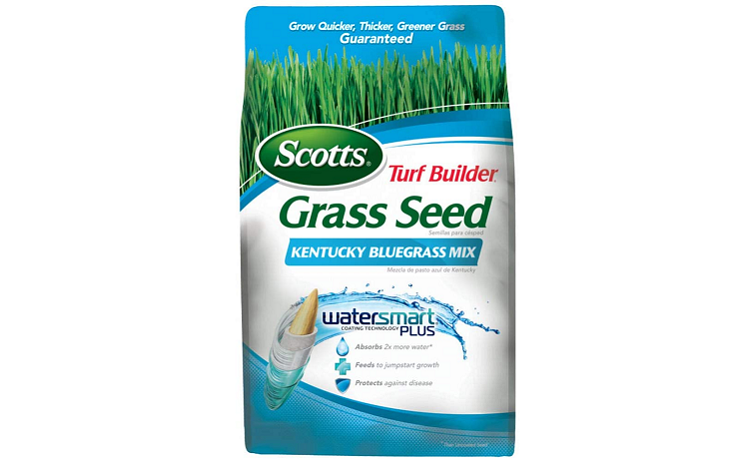
Scotts Kentucky Bluegrass is one of the most commonly used grass seeds in the Northeast. It’s one of the best grass types for overseeding.
Scott’s products often come with an upgrade that will allow the seeds to absorb twice the water, which leads to healthier growth and it’s less likely to contract diseases.
Pros
- Bluegrass is great at withstanding heavy foot traffic, and it is quick at repairing itself
- It can be grown in various temperatures, making it accessible for people who get inconsistent weather.
- Bluegrass has the best resistance to colder weather.
Cons
- It’s high maintenance
- In higher heat conditions and drought, it’ll brown easily.
Frequently Asked Questions
Answer: Sod is the more expensive product, but you get instant results look-wise. It’s also much easier to look after when compared to seeds.
After two to three weeks, the roots will establish, and that’s when it’ll be resistant to high traffic. Seeds will grow in a similar timeframe, but it’ll take a lot more effort to keep them healthy.
Answer: It is ok to mix different types of seed, and sometimes it provides the best protection. I recommend you mix Zoysia and Bermudagrass if you’re going to attempt this, as these are the best two grass types for tolerating heavy foot traffic.
Answer: Overseeding will not only improve the quality of your lawn but will also rejuvenate its appearance. You need to overseed as the grass starts to decrease its quality to get the full effect. Kentucky Bluegrass is the best grass type on this list for overseeding.
Answer: In short, yes, grass plugs are popular for tolerating heavy foot traffic. They also have plenty of other benefits.
The biggest issue is that plugs only cover a small amount of ground and should be used more for covering patches of your yard with dead grass.
Conclusion
All the options on this list are excellent at resisting heavy foot traffic. Bermudagrass is best at this, but it does require a lot more maintenance. Zoysia is another excellent choice, but it’s susceptible to weeds more than other options.
If you’re struggling between sod and seed, both are excellent options. Sod will likely cost you more, but you get instant results looks-wise. You’ll still need to wait around 2 weeks for the roots to establish, though. That’s when it will be tolerant to heavy foot traffic, similar to most grass seeds.
Hopefully, this post helped you pick the right grass type for you, and if you’re looking for more tips on improving your yard, we’ve got got an excellent article on the differences between mulch and pine straw.

